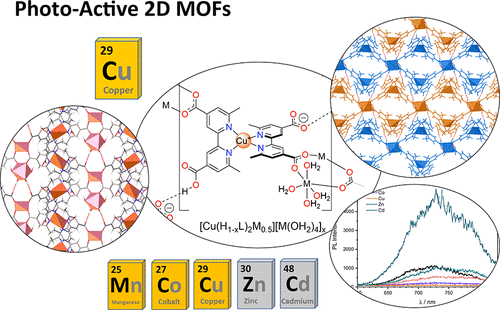当前位置:
X-MOL 学术
›
Inorg. Chem.
›
论文详情
Our official English website, www.x-mol.net, welcomes your
feedback! (Note: you will need to create a separate account there.)
Node-Dependent Photoinduced Electron Transfer in Third-Generation 2D MOFs Containing Earth-Abundant Metal Ions
Inorganic Chemistry ( IF 4.3 ) Pub Date : 2020-11-20 , DOI: 10.1021/acs.inorgchem.0c02475 Friedrich W. Steuber 1 , John J. Gough 2 , Éadaoin Whelan 1 , Lyubomyr Burtnyak 1 , A. Louise Bradley 2 , Wolfgang Schmitt 1
Inorganic Chemistry ( IF 4.3 ) Pub Date : 2020-11-20 , DOI: 10.1021/acs.inorgchem.0c02475 Friedrich W. Steuber 1 , John J. Gough 2 , Éadaoin Whelan 1 , Lyubomyr Burtnyak 1 , A. Louise Bradley 2 , Wolfgang Schmitt 1
Affiliation

|
Five isostructural 2D metal–organic frameworks (MOFs), based on a photoactive CuI metallolinker and mixed mono-/dinuclear secondary building units (SBUs), are reported. The MOFs 1(M) (M = Mn, Co, Cu, Zn, and Cd) exhibit broad absorption across the visible-light spectrum and emission centered at ca. 730 nm. Upon photoexcitation, the rigidity of the framework hinders the pseudo-Jahn–Teller distortion of the metallolinker’s excited state, providing efficient intersystem crossing into the triplet state. Rapid luminescence quenching in 1(Cu) and 1(Co) suggests photoinduced electron transfer (PET) to the SBUs, whereas lifetimes of up to 22.2 ns are observed in 1(Zn). The quantum yields relative to the parent photosensitizer (PS) decrease for metal nodes containing transition metal ions with partially occupied d-orbitals but increase for the d10 systems CdII and ZnII by a factor of up to 6. Importantly, the excited state decay rates directly correlate with the occupancy of the [MII(OH2)]x moieties in the MOFs providing nonradiative decay pathways via O–H oscillators. Cyclovoltammetry reveals minor changes in CuI/II oxidation potential, with excited-state reduction potentials for 1(M) rivalling Ru analogues. These results establish bis(diimine)copper(I) photosensitizers as viable metallolinkers for MOFs and present a rare example of an isostructural series obtained from a photosensitive metallolinker.
中文翻译:

包含地球上大量金属离子的第三代2D MOF中依赖于节点的光诱导电子转移
据报道,基于光敏Cu I金属交联剂和混合的单/双核二级建筑单元(SBU),五个同构的二维金属有机框架(MOF)。MOF 1(M)(M = Mn,Co,Cu,Zn和Cd)在可见光谱范围内表现出广泛的吸收性,并且发射集中在ca处。730纳米 光激发时,骨架的刚性阻碍了金属连接剂激发态的拟Jahn-Teller变形,从而提供了有效的系统间交叉进入三重态。1(Cu)和1(Co)中的快速发光淬灭表明向SBU进行了光致电子转移(PET),而在1(Zn)中观察到的寿命高达22.2 ns。相对于母体光敏剂(PS)的量子产率会降低,其中包含具有部分占据d轨道的过渡金属离子的金属节点,而对于d 10系统Cd II和Zn II则增加多达6倍。衰变速率与MOF中[M II(OH 2)] x部分的占有率直接相关,从而通过O–H振荡器提供非辐射衰变路径。循环伏安法显示Cu I / II氧化电位有微小变化,激发态还原电位为1(M)竞争对手汝类似物。这些结果将双(二亚胺)铜(I)光敏剂确立为MOF的可行金属硅氧烷,并提出了从光敏金属硅氧烷获得的同构系列的罕见例子。
更新日期:2020-12-07
中文翻译:

包含地球上大量金属离子的第三代2D MOF中依赖于节点的光诱导电子转移
据报道,基于光敏Cu I金属交联剂和混合的单/双核二级建筑单元(SBU),五个同构的二维金属有机框架(MOF)。MOF 1(M)(M = Mn,Co,Cu,Zn和Cd)在可见光谱范围内表现出广泛的吸收性,并且发射集中在ca处。730纳米 光激发时,骨架的刚性阻碍了金属连接剂激发态的拟Jahn-Teller变形,从而提供了有效的系统间交叉进入三重态。1(Cu)和1(Co)中的快速发光淬灭表明向SBU进行了光致电子转移(PET),而在1(Zn)中观察到的寿命高达22.2 ns。相对于母体光敏剂(PS)的量子产率会降低,其中包含具有部分占据d轨道的过渡金属离子的金属节点,而对于d 10系统Cd II和Zn II则增加多达6倍。衰变速率与MOF中[M II(OH 2)] x部分的占有率直接相关,从而通过O–H振荡器提供非辐射衰变路径。循环伏安法显示Cu I / II氧化电位有微小变化,激发态还原电位为1(M)竞争对手汝类似物。这些结果将双(二亚胺)铜(I)光敏剂确立为MOF的可行金属硅氧烷,并提出了从光敏金属硅氧烷获得的同构系列的罕见例子。









































 京公网安备 11010802027423号
京公网安备 11010802027423号